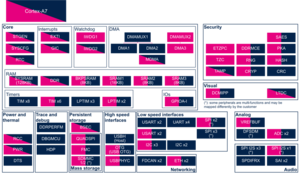1. Article purpose[edit | edit source]
The purpose of this article is to:
- briefly introduce the DFSDM peripheral and its main features,
- indicate the peripheral instances assignment at boot time and their assignment at runtime (including whether instances can be allocated to secure contexts),
- list the software frameworks and drivers managing the peripheral,
- explain how to configure the peripheral.
2. Peripheral overview[edit | edit source]
The DFSDM (Digital Filter for Sigma-Delta Modulator) peripheral is used as a generic ADC. It benefits from external analog frontend interfaces and internal digital filters.
It can be used in various applications[1] such as: audio record with MEMS microphones, energy measurement with STPMS2[2] for electricity meters or motor control...
The DFSDM peripheral provides several features, among which:
- Serial or parallel input channels:
- Digital filters, that offers up to 24-bit final ADC resolution
- Conversions that can be launched continuously, or using various triggers: by software, TIM[5], LPTIM[6], EXTI[7] or synchronously with DFSDM filter 0
- Event detectors: analog watchdog high/low thresholds, short-circuit detector, extremes detector
- Break generation to TIM[5] on analog watchdog or short-circuit detector events
| DFSDM features | Number of channels | Number of filters |
|---|---|---|
| STM32MP13x lines |
4 | 2 |
| STM32MP15x lines |
8 | 6 |
Refer to the STM32 MPU reference manuals for the complete list of features, and to the software frameworks and drivers, introduced below, to see which features are implemented.
3. Peripheral usage[edit | edit source]
This chapter is applicable in the scope of the OpenSTLinux BSP running on the Arm® Cortex®-A processor(s), and the STM32CubeMPU Package running on the Arm® Cortex®-M processor.
3.1. Boot time assignment[edit | edit source]
The DFSDM peripheral is not used at boot time.
3.2. Runtime assignment[edit | edit source]
3.2.1. On STM32MP13x lines  [edit | edit source]
[edit | edit source]
Click on ![]() to expand or collapse the legend...
to expand or collapse the legend...
Check boxes illustrate the possible peripheral allocations supported by the OpenSTLinux BSP:
- ⬚ means that the peripheral can be assigned to the given runtime context, but this configuration is not supported in OpenSTLinux BSP.
- ☐ means that the peripheral can be assigned to the given runtime context.
- ☑ means that the peripheral is assigned by default to the given runtime context and that the peripheral is mandatory for the OpenSTLinux BSP.
- ✓ is used for system peripherals that cannot be unchecked because they are hardware connected in the device.
Refer to How to assign an internal peripheral to an execution context for more information on how to assign peripherals manually or via STM32CubeMX.
The present chapter describes STMicroelectronics recommendations or choice of implementation. Additional possibilities might be described in STM32MP13 reference manuals.
| Domain | Peripheral | Runtime allocation | Comment | ||
|---|---|---|---|---|---|
| Instance | Cortex-A7 secure (OP-TEE) |
Cortex-A7 nonsecure (Linux) | |||
| Analog | DFSDM | DFSDM | ☐ | Assignment (single choice) | |
3.2.2. On STM32MP15x lines  [edit | edit source]
[edit | edit source]
Click on ![]() to expand or collapse the legend...
to expand or collapse the legend...
Check boxes illustrate the possible peripheral allocations supported by the OpenSTLinux BSP:
- ⬚ means that the peripheral can be assigned to the given runtime context, but this configuration is not supported in OpenSTLinux BSP.
- ☐ means that the peripheral can be assigned to the given runtime context.
- ☑ means that the peripheral is assigned by default to the given runtime context and that the peripheral is mandatory for the OpenSTLinux BSP.
- ✓ is used for system peripherals that cannot be unchecked because they are hardware connected in the device.
Refer to How to assign an internal peripheral to an execution context for more information on how to assign peripherals manually or via STM32CubeMX.
The present chapter describes STMicroelectronics recommendations or choice of implementation. Additional possiblities might be described in STM32MP15 reference manuals.
| Domain | Peripheral | Runtime allocation | Comment | |||
|---|---|---|---|---|---|---|
| Instance | Cortex-A7 secure (OP-TEE) |
Cortex-A7 nonsecure (Linux) |
Cortex-M4 (STM32Cube) | |||
| Analog | DFSDM | DFSDM | ☐ | ☐ | Assignment (single choice) | |
4. Software frameworks and drivers[edit | edit source]
Below are listed the software frameworks and drivers managing the DFSDM peripheral for the embedded software components listed in the above tables.
- Linux®: IIO framework or ALSA framework
- STM32Cube: HAL DFSDM driver
5. How to assign and configure the peripheral[edit | edit source]
The peripheral assignment can be done via the STM32CubeMX graphical tool (and manually completed if needed).
This tool also helps to configure the peripheral:
- partial device trees (pin control and clock tree) generation for the OpenSTLinux software components,
- HAL initialization code generation for the STM32CubeMPU Package.
The configuration is applied by the firmware running in the context in which the peripheral is assigned.
For the Linux kernel configuration, please refer to DFSDM device tree configuration and DFSDM Linux driver articles.
6. How to go further[edit | edit source]
See:
- STM32L4 System Digital Filter for SD Modulators interface[1], online DFSDM training with application examples from STMicroelectronics
- Getting started with sigma-delta digital interface[8], application note from STMicroelectronics
7. References[edit | edit source]
- ↑ 1.0 1.1 STM32L4 System Digital Filter for SD Modulators interface, online DFSDM training from STMicroelectronics
- ↑ STPMS2 "Smart sensor" device
- ↑ ADC internal peripheral
- ↑ DMA internal peripheral
- ↑ 5.0 5.1 TIM internal peripheral
- ↑ LPTIM internal peripheral
- ↑ EXTI internal peripheral
- ↑ Getting started with sigma-delta digital interface, application note from STMicroelectronics

